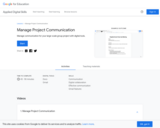
Manage communication for your large-scale group project with digital tools. Time to complete: 45-90 minutes
- Subject:
- Technology
- Material Type:
- Lesson
- Lesson Plan
- Provider:
- Provider Set:
- Applied Digital Skills
- Date Added:
- 05/03/2022

Manage communication for your large-scale group project with digital tools. Time to complete: 45-90 minutes
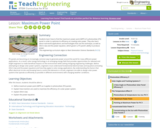
Students learn how to find the maximum power point (MPP) of a photovoltaic (PV) panel in order to optimize its efficiency at creating solar power. They also learn about real-world applications and technologies that use this technique, as well as Ohm's law and the power equation, which govern a PV panel's ability to produce power.
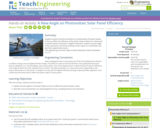
Students examine how the orientation of a photovoltaic (PV) panel relative to the sun affects the efficiency of the panel. Using sunshine (or a lamp) and a small PV panel connected to a digital multimeter, students vary the angle of the solar panel, record the resulting current output on a worksheet, and plot their experimental results.
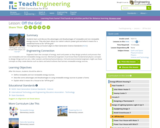
Students learn and discuss the advantages and disadvantages of renewable and non-renewable energy sources. They also learn about our nation's electric power grid and what it means for a residential home to be "off the grid."

Create a digital agenda by adding events, tasks, and reminders in Google Calendar. Time to complete: 45-90 minutes

Students are introduced to passive solar design for buildings an approach that uses the sun's energy and the surrounding climate to provide natural heating and cooling. They learn about some of the disadvantages of conventional heating and cooling and how engineers incorporate passive solar designs into our buildings for improved efficiency.
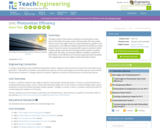
Through a series of four lessons, students are introduced to many factors that affect the power output of photovoltaic (PV) solar panels. Factors such as the angle of the sun, panel temperature, specific circuit characteristics, and reflected radiation determine the efficiency of solar panels. These four lessons are paired with hands-on activities in which students design, build and test small photovoltaic systems. Students collect their own data, and examine different variables to determine their effects on the efficiency of PV panels to generate electrical power.

Machines and friction, the efficiency of a machine and how to calculate it.
A free CK-12 account is required to view all materials.

Explore kinetic and potential energy by towing objects up a frictionless slope.
A free CK-12 account is required to view all materials.
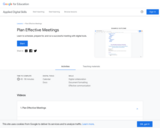
Learn to schedule, prepare for, and run a successful meeting with digital tools. Time to complete: 45-90 minutes

Student teams measure voltage and current in order to determine the power output of a photovoltaic (PV) panel. They vary the resistance in a simple circuit connected to the panel to demonstrate the effects on voltage, current, and power output. After collecting data, they calculate power for each resistance setting, creating a graph of current vs. voltage, and indentifying the maximum power point.
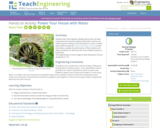
Students learn how engineers design devices that use water to generate electricity by building model water turbines and measuring the resulting current produced in a motor. Student teams work through the engineering design process to build the turbines, analyze the performance of their turbines and make calculations to determine the most suitable locations to build dams.
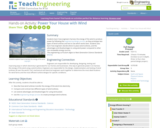
Students learn how engineers harness the energy of the wind to produce power by following the engineering design process as they prototype two types of wind turbines and test to see which works best. Students also learn how engineers decide where to place wind turbines, and the advantages and disadvantages to using wind power compared to other non-renewable energy sources.
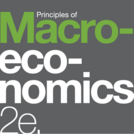
Principles of Macroeconomics 2e covers the scope and sequence of most introductory economics courses. The text includes many current examples, which are handled in a politically equitable way. The outcome is a balanced approach to the theory and application of economics concepts. The second edition has been thoroughly revised to increase clarity, update data and current event impacts, and incorporate the feedback from many reviewers and adopters. Changes made in Principles of Macroeconomics 2e are described in the preface and the transition guide to help instructors transition to the second edition. The first edition of Principles of Macroeconomics by OpenStax is available in web view here.


By the end of this section, you will be able to:
Contrast consumer surplus, producer surplus, and social surplus
Explain why price floors and price ceilings can be inefficient
Analyze demand and supply as a social adjustment mechanism
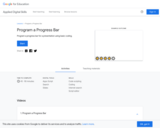
Program a progress bar for a presentation using basic coding. Time to complete: 45-90 minutes

Pumps are used to get drinking water to our houses every day! And in disaster situations, pumps are essential to keep flood water out. In this hands-on activity, student groups design, build, test and improve devices to pump water as if they were engineers helping a rural village meet their drinking water supply. Students keep track of their materials costs, and calculate power and cost efficiencies of the prototype pumps. They also learn about different types of pumps, how they work and useful applications.

Build the capacity to create solutions to help you efficiently and effectively support teachers. The learner will acquire strategies to aid in building teacher capacity to build a sustainability/scalability plan for leveraging instructional technology for the following school year.
Approximate time to complete this course is 3 hours. A micro-credential is available from Digital Promise upon completion.

A University of Nottingham physicist explains how a jet engine works, and demonstrates a jet engine's propulsion efficiency using a water-propelled rocket made from a soda bottle. [6:01]